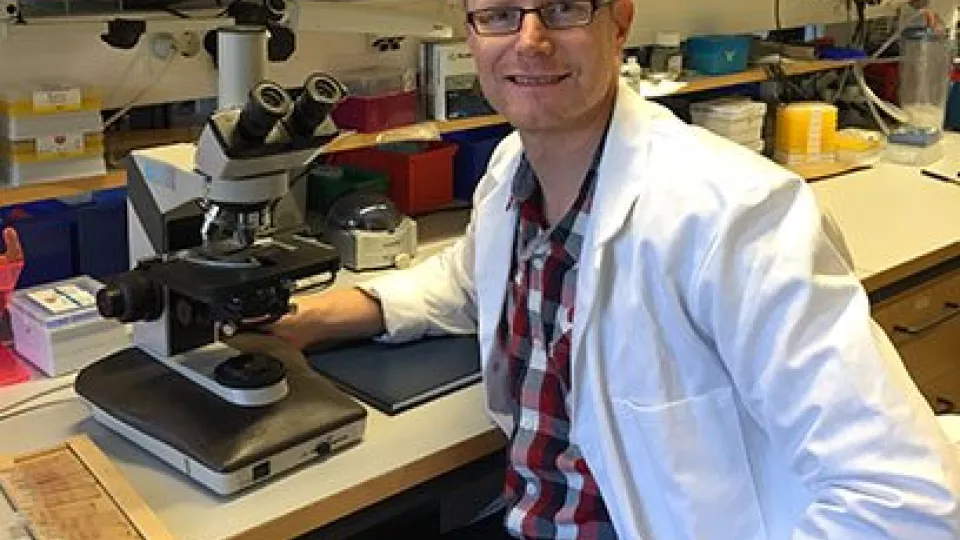One of these key players is a receptor called TLR4. The receptor plays such an important role in the body’s innate immune system that the researchers who discovered it were awarded the 2011 Nobel Prize in Physiology or Medicine. The other key player is a protein called galectin-3, which is absent in healthy brains but present in a brain suffering ongoing inflammation.
“We have demonstrated that galectin-3 is secreted by microglial cells, a type of immune cell in the brain. The protein binds to the TLR4 receptor and amplifies the reactions that lead to inflammation. More galectin-3 is produced and binds to the immune cells, and the immune response is further intensified in a self-sustaining process”, explained Tomas Deierborg, associate professor at Lund University.
The researchers have demonstrated the importance of the link between the two ‘key players’ using various different methods and in laboratory tests, animal experiments and human trials. They have shown that mice genetically modified to be incapable of synthesising galectin-3 show a lower inflammatory response and less brain damage after model mimicking a heart attack. Mice with a model of Parkinson’s disease also suffer less brain damage if they do not have the gene for galectin-3. The researchers have also observed the interaction between galectin-3 and TLR4 in the brains of people who died of a stroke.
“We believe that this link could be part of the explanation for the residual disability that stroke patients often experience. High levels of galectin-3 remain in the brains of these patients long after the stroke, which may explain why the inflammatory response continues to cause damage and does not subside”, said Miguel Angel Burguillos.
Originally from Spain, Dr Burguillos is currently working at Queen Mary University of London, but carried out the work on galectin-3 and TLR4 during his time as a postdoctoral fellow at Lund University and Karolinska Institutet. The research in Lund has been led by Tomas Deierborg and at KI by Bertrand Joseph. The University of Seville also participated in the research, led by José L. Venero. The results have recently been published in the journal Cell Reports.
Galectin-3 is already a target for pharmaceutical companies trying to develop agents that hinder the harmful effects of the protein in neuroinflammatory diseases. The new findings on the effects and role of the protein in a diseased or damaged brain should provide important input to this work.
“Previously, it was acknowledged that galectin-3 contributed to the inflammatory response but the mechanism wasn’t clear. The protein is not present in a healthy brain, only in one that is suffering an inflammatory response. Now that we understand the mechanism, this will make it easier to develop more effective treatments”, said Dr Deierborg.
Publication: Microglia-Secreted Galectin-3 Acts as a Toll-like Receptor 4 Ligand and Contributes to Microglial Activation
Contact:
Associate Professor Tomas Deierborg, PhD, Lund University Faculty of Medicine
+46 709 70 82 12
tomas [dot] deierborg [at] med [dot] lu [dot] se (tomas[dot]deierborg[at]med[dot]lu[dot]se)
Senior Research Fellow Miguel Angel Burguillos, PhD, Queen Mary University of London
+44 20 7882 8813
m [dot] burguillos [at] qmul [dot] ac [dot] uk (m[dot]burguillos[at]qmul[dot]ac[dot]uk)
Funding:
This work has been supported by the following grants (in alphabetical order): A.E. Berger Foundation, Bergvall Foundation, Crafoord Foundation, G & J Kock Foundation, Gyllenstiernska Krapperup Foundation, Lars Hierta Memorial Foundation, Proyecto de Excelencia from Junta de Andalucia (CTS-6494), Royal Physiographic Society in Lund, Spanish Ministerio de Ciencia y Tecnología (SAF2009-13778), Swedish Childhood Cancer Society, Swedish Parkinson Foundation, Swedish Research Council (2012-2229), Swedish Strategic Research Area MultiPark at Lund University, Swedish National Stroke Foundation and Wiberg foundation.
